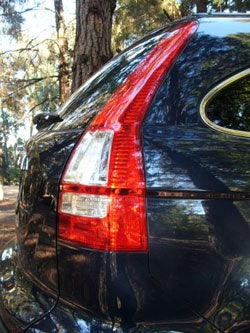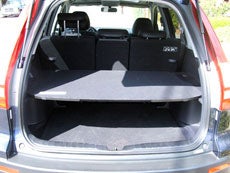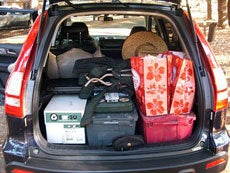Keeps Getting Better: 2007 Honda CR-V 4WD
Real Time 4-Wheel Drive does all the thinking in bad weather situations.
ORC REVIEW
Aside from a striking new look, the CR-V gets an integrated Navigation option on the EX-L model, which includes voice activated control, XM radio, and an in-dash CD player that can play MP3s and WMAs. It also has a 6-Disc CD changer in the center console and a PC Card (PCMCIA) slot in the unit for flash memory MP3 or WMA files. A rear backup camera is also included. Also, a top-hinged tailgate replaces the side-hinged tailgate design. I drove a 2007 5-passenger Honda CR-V EX-L 4WD with Real Time™ 4-wheel drive. Total vehicle price is $28,595. Mileage estimates for this trim are 20-mpg city and 26-mpg highway driving. CR-V FIRST IMPRESSIONS
Honda made a wise choice to remove the CR-V's boxy look and go sleek with an arched side window and lowered stance. In Honda's words, it "embraces curves and fluid design over the upright and traditional two-box SUV shape." It definitely leaves the old CR-V's body design in the dust. The large 17-inch tires accentuate its SUV proportions and give it some aggressiveness. The side sill step-in height has been lowered by 1.3 inches. Some of the EX-L model interior features that automatically caught my eye were the leather seats, leather-trimmed steering wheel, sunroof, and Navigation system. Sure, it was comfortable and ergonomically correct when sitting and driving, but even at the highest trim it is still not nearly as upscale as many of the other compact SUVs on the market. I was taken aback with its roominess and spacious feeling, but I wanted to process this before I came up with an opinion. The CR-V does not have the best usages of space in relation to the center console. The shifter was situated up too high, and a more elaborate center console could have glossed the interior and impressed more upon first entry. The EX-L is supposed to be the highest level of trim. In the back, the seats fold down easily, but the cargo space has been a bit compromised because of the new styling. Compared to its predecessor, the 2007 CR-V body is 3.7 inches shorter (largely due to the relocation of the spare tire) in overall length (177.9 inches), 1.4 inches wider in overall width (71.6 inches) and the 66.1-inch height is 0.1 inches shorter. The overall vehicle weight, however, remains similar to previous models. Despite these changes, I found it roomy enough for a weekend camping getaway and all the gear needed for two. CR-V OFF-ROAD CAPABILITY The 4-cylinder engine was solid, but not too heavy hitting during high-speed hill acceleration, although improvement on this level is being advertised. It's as responsive during acceleration and braking as any other Honda; sometimes I think Hondas are too responsive in their engineering. The brake and gas pedal are too touchy for my taste and driving style and cause a lot of jerking around. Honda describes the vehicle as "energetic," and I guess it's this energy I'm concerned about. Honda feels no need to step up and put a V6 into this vehicle. I loved the fact I could commute to the gym in traffic, run errands, and make it up to my camping destination without having to fill up once. I guess there are other compact SUVs on the market that can beat the gas mileage, but it is pretty impressive when you consider the sticker price and an approximate average of 23-mpg for a compact SUV. But still, that's what you get for a V6. The CR-V has what is called a Real Time™ 4-wheel drive. The system is designed to handle realistic bad-weather encounters. The Real Time 4WD system is fully automatic. It’s going to take care of business whether you know it or not. Supposedly for 2007, the system has been enhanced resulting in 20 percent more torque transfer to the rear wheels. The Real Time 4WD system sends power to the rear wheels only when there is insufficient traction. The system consists of the conventional front-wheel-drive system, a compact transfer case that distributes torque to a propeller shaft running the length of the vehicle, a dual-pump system with a multi-plate clutch, a cam unit mechanism, the rear differential, and left and right rear-wheel driveshafts. The core of the system is the dual-pump unit. It consists of two hydraulic pumps, one driven by the front wheels via the propeller shaft and one driven by the rear wheels via the rear differential. A hydraulically actuated, multi-plate clutch, similar to the clutches used in Honda automatic transmissions, connects the propeller shaft to the rear differential. When the CR-V is operating with the front and rear wheels turning at the same speed, (like on dry pavement,) the front and rear hydraulic pumps operate at the same rate. Hydraulic fluid circulates between the two pumps; however, no pressure is generated. If the front wheels begin to turn faster than the rear wheels, as would be the case if they were spinning on snow or ice, the two hydraulic pumps would turn at a different rate and hydraulic pressure proportional to the difference in their speeds of rotation would be generated. The resulting hydraulic pressure opens a valve body and feeds pressure to the multi-plate clutch, which engages the front propeller shaft to the rear differential. The rear differential then feeds the drive torque to the right and left rear wheels. Got that? CR-V IMPROVES LIFTGATE
The Honda Satellite-Linked Navigation System features a 6.5-inch display. The navigation system features more than 6 million points of interest and the voice recognition is capable of recognizing and inputting numbers, street names and cities, along with controlling the audio system. The audio system is more powerful by 160 watts. As much as 270 watts and seven speakers, including a subwoofer, are available on the EX-L with Navigation. Auxiliary audio input jacks are standard equipment on all trim levels, allowing for portable music device playback through the CR-V's speakers. XM® Satellite Radio is standard on the EX-L. All CR-V audio systems have MP3/WMA CD playback capability and Speed-Sensitive Volume Control (SVC) that automatically adjusts the volume based on vehicle speed. The top-hinged tailgate replaces the side-hinged tailgate design and opens vertically, allowing cargo loading from the left or right sides of the vehicle. Better for tailgating. Believe it or not, not all tail lifts and gates are convenient for fun, shopping and cargo hauling. No one likes to set groceries down; you should be able to lift your back gate at the push of a button. I especially liked this when loading and unloading camping gear. Assisted by hydraulic dampers, special hinges allow the top section of the lightweight tailgate to rotate optimally for low open and close loads. IS IT TOUGH ENOUGH? When I am inside a car with AWD or 4WD capability, I want to feel that capability inside and out, no matter the size of the Crossover or SUV. Call it a personal preference. For ORC readers, I'm going to go with the idea we like our SUVs and CUVs to have that all-round off-road feel, as if we’re on our way to hit the trail rather than drop the kids off at soccer practice. |






 Your Privacy Choices
Your Privacy Choices